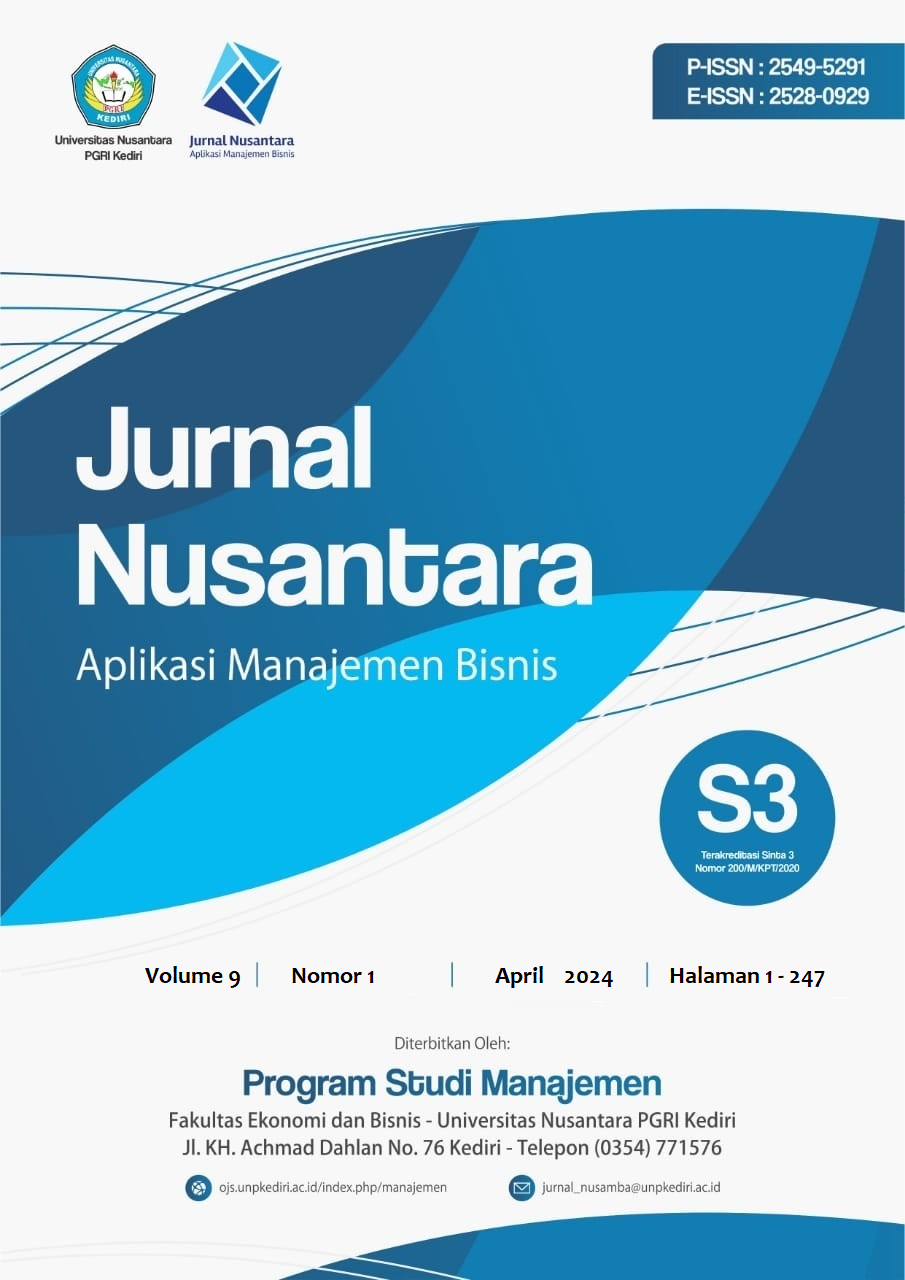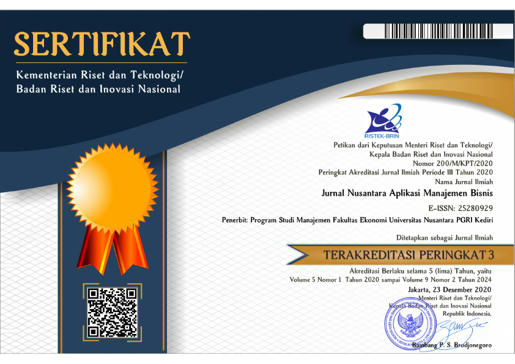Pengembangan Produk Celana Denim Berbasis Preferensi Konsumen Untuk Meningkatkan Keunggulan Bersaing
DOI:
https://doi.org/10.29407/nusamba.v9i1.20645Keywords:
MSMEs, product development, consumer preferences, competitive advantage, conjoint analysisAbstract
Research aim : This research aims to explore consumer preferences which will be used as a basis for product development in Micro, Small, and Medium Enterprises (MSMEs) that have received limited market response.
Design/Methode/Approach : This research uses a survey research model with conjoint analysis method.
Research Finding : The research findings indicate that developing products in Micro, Small, and Medium Enterprises (MSMEs) based on consumer preferences can enhance competitive advantage.
Theoretical contribution/Originality : This research also proves that developing products in Micro, Small, and Medium Enterprises (MSMEs) based on consumer preferences through market surveys can effectively identify market needs.
Practitionel/Policy implication : Developing products in Micro, Small, and Medium Enterprises (MSMEs) based on consumer preferences plays a role in increasing sales, enhancing product value, and improving competitiveness.
Research limitation : In an effort to enhance the competitive advantage of Micro, Small, and Medium Enterprises (MSMEs), this research only focuses on the development of their products.
Downloads
References
[2] Affandi A, Sarwani, Sobarna A, Erlangga H, Siagian AO, Purwanto A, et al. Optimization of MSMEs empowerment in facing competition in the global market during the COVID-19 pandemic time. Systematic Reviews in Pharmacy 2020;11:1506–15. https://doi.org/10.31838/srp.2020.11.213.
[3] Anatan L, Nur N. A Review of MSME’s Competitiveness in Indonesia. Proceedings of the 4th International Conference on Economics, Business and Economic Education Science, European Alliance for Innovation; 2021. https://doi.org/10.4108/eai.27-7-2021.2316891.
[4] Sawitri D, Suswati E. Trenggalek typical food diversification strategies for increasing competitiveness in the SDGS era by using a business model canvas. International Journal of Innovation, Creativity and Change 2019;9:259–72.
[5] Ginting M, Sembiring H. The Effect of Product Innovation, Product Quality And City Image on Purchase Decision of Uis Karo Woven Fabric. Proceedings of the 1st Economics and Business International Conference, Atlantis Press; 2018.
[6] Feng Q, Hui PC-L. What are the factors that influence the adaptive market? An empirical study with wheelchair users in Hong Kong. Journal of Fashion Marketing and Management 2023;27:506–30. https://doi.org/10.1108/JFMM-11-2021-0280.
[7] Jang SY, Ha J. Presenting fabrics in digital environment: fashion designers’ perspectives on communicating tactile qualities of the fabrics. Fashion and Textiles 2023;10. https://doi.org/10.1186/s40691-022-00328-2.
[8] Dzhalolovna MS. The Role of Marketing Research in The Formation of Competitive Advantages. JournalNX-A Multidisciplinary Peer Reviewed Journal 2020;6.
[9] Siswanto VK, Aulia BU, Umilia E, Hekmachtyar I. Mapping and arrangement of development strategy for creative industry of UMKM Kampong Dolly in Surabaya, Case study: Fashion small industry. IOP Conf Ser Earth Environ Sci, vol. 202, 2018. https://doi.org/10.1088/1755-1315/202/1/012074.
[10] Wang H, Hughes DE, Feng H. How Successful Firms Manage the Power Between Sales and Marketing Functions: An Abstract. 2023. https://doi.org/10.1007/978-3-031-24687-6_49.
[11] Gazzola P, Pavione E, Pezzetti R, Grechi D. Trends in the fashion industry. The perception of sustainability and circular economy: A gender/generation quantitative approach. Sustainability (Switzerland) 2020;12:1–19. https://doi.org/10.3390/su12072809.
[12] Tyaswara B, Rizkina Taufik R, Suhadi M, Danyati R, Bahasa Asing BSI Jakarta A. Pemaknaan Terhadap Fashion Style Remaja di Bandung. Jurnal Komunikasi 2017;3:293–7.
[13] An MH, Jang AR. Development of textile pattern design by M. C. Escher’s tessellation technique using chaekgeori icons. Fashion and Textiles 2023;10. https://doi.org/10.1186/s40691-023-00336-w.
[14] Sugiyono. Metode Penelitian Kuantitaif Kualitatif dan R&D. Bandung: Alfabeta; 2013.
[15] Clouse M. Predicting U.S. Adolescents’ Purchasing of Denim Jeans Using Quality Attributes, Behavioral Characteristics, and Quality Attributes, Behavioral Characteristics, and Sociodemographics. Utah State University, 2018.
[16] Banerjee S, Banerjee T. An Analytical Study on the Men’s Denim Wear Market in India-Identification of the Key Factors Influencing the Consumer Buying Behavior in the Economy Segment. Amity Journal of Marketing 2019;4:46–63.
[17] Shukla AK, Shridhar R, Cabigiosu A. A Cross-National Analysis of Intrinsic and Extrinsic Cues’ Preferences of Premium Denim Products : A Case of Levi’s and other Premium / Luxury Denim Brands. Int J Sci Res Sci Eng Technol 2022;9:196–216. https://doi.org/10.32628/ijsrset229524.
[18] Fauzy U. Aplikasi Analisis Konjoin Dengan Model Regresi Logistik Dalam Mengukur Preferensi Mahasiswa Dalam Memilih Handphone. Jurnal Matematika UNAND 2014:132–9.
[19] Nurhayati L, Bellanov A. Analisis Preferensi Konsumen untuk Merancang Atribut Café dengan Menggunakan Metode Konjoin. Jurnal Teknik Industri 2023;9:281–90.
[20] Hwang Shin S-J, Fowler D, Lee J. Teens and College Students’ Purchasing Decision Factors of Denim Jeans In the United States. Fashion & Textile Research Journal 2013;15:971–6. https://doi.org/10.5805/sfti.2013.15.6.971.
[21] Toklu IT. The Importance of Denim Jeans Attributes for Young Consumers. Journal of Turkish Studies 2018;13:459–76. https://doi.org/10.7827/turkishstudies.14324.
[22] Shanwar H. Consumer perceptual study for new product development-A research study for Pepe Jeans. Mumbai: 2018.
[23] Shikder AAR, Emon JH, Khan HK, Hasan M, Siddiquee AB. Impact of Washing Process on the Physical Properties of Denim Fabric (Twill and Dobby). European Journal of Engineering and Technology Research 2021;6:77–81. https://doi.org/10.24018/ejers.2021.6.7.263.
[24] Hair JF, Black WC, Babin BJ, Anderson RE. Multivariate Data Analysis. 7th ed. Pearson Education; 2019.
[25] Ong AKS, Prasetyo YT, Picazo KL, Salvador KA, Miraja BA, Kurata YB, et al. Gym-goers preference analysis of fitness centers during the covid-19 pandemic: A conjoint analysis approach for business sustainability. Sustainability (Switzerland) 2021;13. https://doi.org/10.3390/su131810481.
[26] Ong AKS, Prasetyo YT, Libiran MADC, Lontoc YMA, Lunaria JA V., Manalo AM, et al. Consumer preference analysis on attributes of milk tea: A conjoint analysis approach. Foods 2021;10. https://doi.org/10.3390/foods10061382.
[27] Prasetyo YT, Suzianti A, Dewi AP. Consumer Preference Analysis on Flute Attributes in Indonesia using Conjoint Analysis. International Conference on Advanced Design Research and Education , Research Publishing Services; 2014, p. 111–7. https://doi.org/10.3850/978-981-09-1348-9_038.
[28] Ong AKS, Prasetyo YT, Young MN, Diaz JFT, Chuenyindee T, Kusonwattana P, et al. Students’ preference analysis on online learning attributes in industrial engineering education during the covid-19 pandemic: A conjoint analysis approach for sustainable industrial engineers. Sustainability (Switzerland) 2021;13. https://doi.org/10.3390/su13158339.
[29] Kaukab ME. Strategi Pengembangan Produk UMKM Menuju Pasar Bebas Global. Wonosobo: UNSIQ Press; 2020.
[30] Lekshmi RS, Rajamani K. Consumer Preference towards Global Products. Shanlax International Journal of Management 2022;5.
Downloads
Published
Issue
Section
License
Authors who publish with this journal agree to the following terms:
- Copyright on any article is retained by the author(s).
- The author grants the journal, the right of first publication with the work simultaneously licensed under a Creative Commons Attribution License that allows others to share the work with an acknowledgment of the work’s authorship and initial publication in this journal.
- Authors are able to enter into separate, additional contractual arrangements for the non-exclusive distribution of the journal’s published version of the work (e.g., post it to an institutional repository or publish it in a book), with an acknowledgment of its initial publication in this journal.
- Authors are permitted and encouraged to post their work online (e.g., in institutional repositories or on their website) prior to and during the submission process, as it can lead to productive exchanges, as well as earlier and greater citation of published work.
- The article and any associated published material is distributed under the Creative Commons Attribution-ShareAlike 4.0 International License












